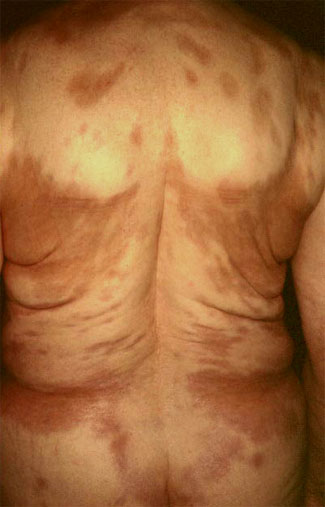Diseases of the skin: the Deep Morphea

Deep morphea belongs to a group of diseases called scleroderma. Scleroderma is a chronic disease that involves the microvasculature and connective tissue and results in fibrosis. Two different clinical categories are generally identified: systemic sclerosis, in which visceral changes are present, and localized scleroderma (morphea), in which lesions are limited to the skin.
Clinically, in deep morphea plaques are mildly inflamed, hyperpigmented, symmetrical, and somewhat ill-defined. The skin feels thickened and bound down to the underlying fascia and muscle. Plaques are smooth and shiny, but areas of both dermal and subcutaneous atrophy may be present, particularly in chronic lesions. In addition to skin lesions, flexion contractures of joints are a relatively frequent finding and a carpal tunnel syndrome may be present as well.
Arthralgias, arthritis, or myalgias are commonly present. Also, evidence of pulmonary and esophageal anomalies, and even renal or cardiac disease, have been documented in patients with morphea profunda. Peripheral eosinophilia, high serum gamma-globulin or IgG levels, increased ESR, and serologic abnormalities including the presence of types of autoantibodies, have been noted in these patients. The treatment of deep morphea is still unsatisfactory and is not standardized, but UVA irradiation, anti-inflammatory drugs and immunosuppressive agents, mainly antimalarials and systemic corticosteroids, can be useful.Several types of localized sclerosis or morphea may be distinguished on the basis of clinical manifestations and levels of tissue involvement. Recently, a new classification of localized sclerosis has been proposed; it includes the plaque, generalized, bullous, linear, and deep types and their corresponding subtypes (table I). Essentially, plaque morphea is a superficial type often confined to the dermis, whereas linear morphea consists of one or more indurated linear streaks that may involve the dermis, subcutaneous tissue, muscle, and underlying bone. Deep morphea lesions also involve the deep dermis, subcutaneous tissue, and muscle, but in contrast to linear morphea they are more diffuse and do not show a linear pattern.
Servicio de Dermatología, Hospital Universitari Germans Trias i Pujol. Badalona.
References
"Deep Morphea" Bielsa I, Ariza A.Seminars in Cutaneous Medicine and Surgery, 2007 Jun;26(2):90-5.


